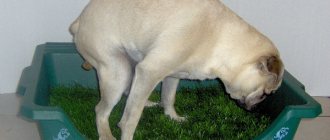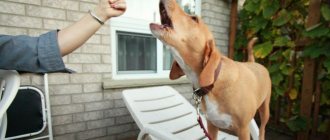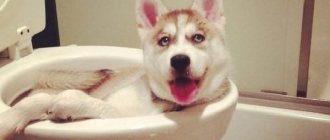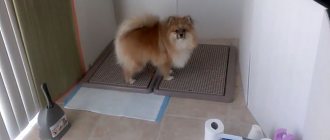When getting the first dog in life, a person begins to ask many important questions. And one of them is how to train a dog to stay alone at home. This is really important - separation, even temporary, always hits hard on a pet, who knows that his beloved owner leaves home for a long time every day, but does not understand what sins he is being punished for. And the wrong behavior of a person can further aggravate the situation. Let's try to understand how to act to solve this problem.
Signs of anxiety
Quite often, even an adult dog, not to mention a puppy, noticing that the beloved owner is getting dressed, collecting things and going to the door, forgetting to grab the pet, falls into a panic. She begins to whine, bark, get underfoot, lie down on the threshold, blocking the way, and even grab her legs with her teeth. This is unpleasant and even dangerous - a young dog may well miscalculate his strength and injure his owner. And not every person can withstand the almost crying look of a dog.
However, this is quite natural - something worth understanding if you want to know how to train your dog to stay home alone. There is no need to worry, even if at these moments she shows certain signs of illness, such as a suddenly dry and warm nose. This is stress that can be easily eliminated with simple training. But first you need to understand why the dog shows its feelings so clearly.
Causes of excitement
Everything here is surprisingly simple. A dog, especially a young one, is extremely emotional. Look at people - an adult, knowing that close people are leaving him, also worries and feels discomfort. But he easily subordinates his feelings, does not demonstrate them, understanding that no one wants to be separated, but this is a necessity. The child shows feelings much more vividly - asks not to leave, cries, begins to play around.
The situation is exactly the same with a dog. When she gets a little older, it will go away.
It's a different matter if the dog is afraid to be left alone at home. What to do in such a situation? Unfortunately, such problems are almost always the fault of the owner himself.
On the one hand, it is generally not advisable to have a dog if it spends 8-12 hours a day alone. Imagine yourself in her place. The fate of spending half your life alone, not being able to do the things you love, is far from sugar.
Therefore, you need to give your pet the opportunity to spend the time you spend together as interesting and eventful as possible.
Regular walks
Quite often, people who do not devote enough time to their pet have to find a way to train an adult dog to stay home alone. Because you are so busy, you have to hastily walk the dog, spending only a few minutes, and sometimes skipping this most important and favorite activity. Would you like it if you were deprived of your bonus without explanation at the end of the month?
Therefore, try to walk your dog at the same time, and for as long as possible. If possible, let the dog run around to its heart's content, play with friends, and not just obediently follow you on a leash.
Active rest will allow your pet to throw out maximum energy, and when he comes home, he will first of all try to eat and go to sleep, and not worry about the fact that his owner left him for a long time.
And just regular walks without passes allow the dog to be confident in the inviolability of the established world. Therefore, she will react much more calmly to the fact that after a long walk the owner leaves her alone at home, and almost immediately after returning they will take a walk together in their favorite park.
Movement and awards
If the owner leaves the dog alone in the apartment for a long time, the animal suffers without people. Unfortunately, destroying household appliances is usually a dog's only way to recover from the stress of loneliness. There is nothing worse than punishing an animal for such crimes. Then, in addition to the nervousness caused by loneliness, the dog develops fear, and as a result, the habit of doing all sorts of dirty tricks.
Homemade creams save from aging skin on hands: banana with honey and other recipes
We installed lighting in the kitchen under the wall cabinets: a simple way
A living New Year's beauty in Yalta was dressed up with toilet paper
The only way to break this vicious cycle is to provide the appropriate amount of exercise for the dog in the home, and then reward him if everything in the home remains intact. Of course, you should initially leave the dog alone for very short periods of time, and then gradually increase such periods of solitude.
Mistakes when breaking up
Another common mistake that causes breeders to rack their brains on how to train a dog to stay alone at home is improper separation and greeting. Yes, yes, this also plays an important role.
In the morning, the owner leaves for work, the puppy, poorly oriented in the world, not accustomed to the new state of affairs, is worried, whines pitifully, and howls. As a result, the owner (and he also doesn’t have a heart of stone) loses his nerves, he begins to worry, say goodbye to his pet for a long time, and almost cry. And the dog is very sensitive to any changes in mood. Therefore, the initial stress is further amplified by the host's distress. Of course, the puppy does not understand anything that the owner says, but the general intonation additionally frightens him. When a person does leave home (to work, study or other matters), the dog remains confused.
Returning home, the owner, seeing the dog’s joy, will become emotional - and this will additionally add stress and misunderstanding to the pet’s worldview. So the joy of the meeting is mixed with uncertainty, even fear.
This situation repeats itself day after day. The puppy turns into a dog, but the fact that the separation becomes stressful for the couple remains. The owner has to try many techniques before he can figure out how to teach his dog to stay home alone. And this does not always bear fruit.
Teaching independence at home
Dog handlers recommend gradually accustoming the puppy to being in the apartment on its own. To do this, it is necessary not to increase the suffering of the animal by saying goodbye to it tearfully every morning. This will only reinforce your puppy’s negative attitude towards loneliness. It’s better to learn how to convey peace and love to your dog.
For most puppies, the ringing of keys and the owner putting on outerwear in the hallway are alarm bells of impending separation. This means that one must become accustomed to these actions. When you come home from work, after playing with your pupil, make a feint - put on the jacket or coat you usually wear to work in front of him, and jingle the keys.
Gradually getting used to separation means walking out the door and quickly returning. The process of absence can then be lengthened. For example, if you are used to stopping at a store on the way from work, then change your habit for the sake of your pupil. Go home, spend some time with your pet, and then go to the store. This way the dog will get used to your absence for short periods.
Another option for teaching a dog to be alone in an apartment or house is to buy a cage or house. There the puppy will feel calm and safe. This is his personal comfort zone. Dogs, like a street kennel, associate it with reliability and safety. By the way, the dog will sleep more peacefully at night in such a house.
We suggest you read: Heart attack in cats, symptoms and treatment
In general, the ideal option for accustoming a puppy to loneliness in an apartment is when the owner, after purchasing it, takes a vacation or weekend so that during the adaptation period (at least two weeks) he can almost always be with the puppy. During this period, he will more easily cope with getting used to the new environment and separation from his mother, place and nickname, and you will have the opportunity to leave for short periods. You will increase their duration daily. Then the period of adaptation and maturation of the puppy will be smoother and faster.
Proper farewell and meeting
Remember - partings and meetings should not be excessively long. The owner - he is always the alpha in a healthy relationship with the dog - must remain firm, confident, and calm. Say goodbye to your pet briefly and firmly, tell him to behave well, promise to return quickly. The meeting should also not be too emotional. You can pet the dog, hug it, even give it some small treat, but nothing more. Yes, the puppy gets bored being alone. And he can only outgrow this with your help.
We train the dog to part ways
Now for some practical advice that will help you figure out what to do - the dog is not left alone at home. This is best for puppies.
When the young pet gets used to its new place of residence, smells and surroundings, arrange separations more often. But they should be short. Take out the trash, check the mailbox, go to the nearest store for bread. The separation lasts only a few minutes, and all this time the puppy is worried. However, the dog will understand very quickly that every time the owner leaves, he will definitely return, and again he will have the opportunity to play, walk, and do his favorite things.
The main subtlety is to be confident in yourself, so that this confidence is transferred to the dog. Partings will no longer be something scary and incomprehensible for her, and therefore they will be much easier to bear, without unnecessary complications.
Provide leisure time for your pet
Another reason why a dog does not want to be left alone at home is simple boredom. She cannot read books, surf the Internet, watch TV or go for a walk. As a result, it is out of boredom that she begins to have fun as best she can.
As a result, rolls of toilet paper, plastic bags, papers and books that are not put away far enough are torn to shreds. Shoes and any clothing, mobile phones, chargers, remote controls and any other items that are in a place where a young puppy can reach are used. And believe me, he can get almost anywhere.
On the one hand, the pet needs to be punished. But not too harshly - after all, you yourself are partly to blame for this mess. In addition, dogs have short memories, especially puppies. If several hours have passed between the crime and punishment, he may not make the connection. At the same time, in no case should you take all the blame on yourself - having realized that the violation is not followed by punishment, the dog will become completely uncontrollable. Show the offender the damaged object, shout at him and slap him on the butt with a suitable object (not your palm or a leash, so as not to cause fear of petting and walking). It shouldn't hurt him - just an unpleasant sensation. The slap should be accompanied by a shout - sharp, loud and short. The dog must understand that the owner is dissatisfied with his behavior. And any unspoiled puppy or dog really does not like to upset the owner.
To prevent this from happening (or at least not on such a scale), remove all valuable and fragile items away, leave enough food, water and toys so that your pet has something to do while you are not home.
What toys should you give your puppy?
When leaving, leave the puppy toys that are usually not available to him, so that they are new and interesting for him.
Get a large box and put some of the toys there and change the toys every two to three weeks, giving these out and putting the used ones in the box.
Puppies have a short memory and these toys will be like new every time.
A great toy for a puppy left alone at home would be a hefty mosel (fetlock of beef). The bone should be of such a size that the puppy cannot swallow it. Consider the speed of eating and remove the bone in time when it becomes too small.
A stick made from an apple, pear or rowan tree would also be a wonderful nibble. The wood of these trees is soft and produces small, non-sharp chips that will not scratch your puppy's mouth.
Do not leave latex or rubber toys as chewing toys. Sooner or later they will be chewed, and a swallowed piece of rubber can lead to a blockage, which is very dangerous and can lead to the death of the puppy.
If the puppy does not have toys approved for chewing, then he will find them for himself and you will not like his choice.
Never keep old shoes as toys. The puppy is not able to distinguish old shoes from new ones and next time he will choose your dress shoes as toys.
We suggest you read: Heat in cats: duration, frequency and ways to solve the problem
Busy evenings and weekends
Finally, the question of how to teach an adult dog to stay alone at home is often asked by owners who do not pay enough attention to their pet. Remember - it is in you and your family that the whole meaning of the animal’s life is concentrated. For him, you are alpha and omega, the beginning and the end, practically a god.
Pamper him more often, spend as much time with him as possible. An excellent choice would be a regular walk, a joint evening jog (you can ride a bike, matching the dog’s running), and a variety of games.
It is thanks to such a rich life that the dog feels loved and will be much easier to endure separation.
How to train a dog to stay home alone
Do some exercises to train your dog to be left alone.
Have a treat and a timer ready. Put a collar or harness on your dog. Lure her into the room with a treat, give her the treat. Say: “Stay!”, go out, trying to close the door behind you. If the dog tries to go out with you, do not push him away (these exercises assume that the dog has only been in your house for 1-2 days, so he may interpret pushing away as aggression or as an offer to play - both options are not suitable for you now) . Again lure her into the room with a piece, and again try to leave her. Repeat this calmly and persistently over and over again. When you managed to close the door behind you, leaving your pet in the room, immediately say: “Well done!” (the dog learned the word of praise from the first house study game), come back and treat him. Repeat several more times, waiting until the moment when you were able to leave the room three times in a row without any problems. Depending on the character and life experience of the dog, you will succeed in this from the very first repetitions, or only after several days of such training.
After you have calmly left the room and returned three times in a row, you can move on to the next stage. Set the timer for 1 minute. And then begin the exercise in the following sequence:
1 minute in the room with the dog, call, praise, encouragement - get out.
1 minute, leaving the dog alone in the room, call, praise, come in and reward.
Repeat this exercise at least ten times. It is very important to behave relaxed and calm; you can carry a book with you or listen to music. When you are in a room with a dog, do not look at it, do not entertain it, do not pet it. When she is alone in the room, do not talk to her through the door, do not return if she starts barking or scratching the door (it is better to choose a place in advance with a door that is not scary if the dog scratches). Ideally, this will result in the dog lying down and simply waiting while you come in, come out, and give him treats. This exercise can be completed.
When choosing a place where you will leave your pet during exercise, be careful and be prepared to change this place. If your dog still has a hard time trusting you, it will be difficult for him to stay in a small enclosed space, such as a bathroom. In some cases, you can go into the bathroom yourself and leave it behind the door in the hallway instead of closing it in the room and going out into the hallway yourself.
After completing the “minute in a minute” exercise and getting a good result (the dog calmly waits while you walk back and forth), proceed to “reconnaissance in force.” You close zones “c” and “b”, leave the pet in zone “a”, turn on the webcam for monitoring and start leaving the dog in the apartment for a minute, closing the front door behind you. You're training again "in a minute." If all goes well, after 10 repetitions one day and 10 the next, try leaving the dog to have fun and go away for a longer period of time watching him on the webcam.
With all the well-being, the dog will have fun with toys in your absence, and then lie down on its bedding and fall asleep. With these exercises, you helped her feel more comfortable at home, showed her that when you leave, you always come back, and this situation no longer causes such fear in her as before.
However, things are not always so rosy and simple. Many dogs in the shelter are former pets, their experience tells them that the owner may leave and never return... Other pets have a hard time adapting to a new home, are very nervous and cling to you because they need you and your support. Grown-up dogs from the street are usually quite easily left alone in their first home, but, unfortunately, it happens that the dog is brought in to spend the night, then taken to another house, then to a third... The dog feels like he is losing control over the situation, he is no longer in control come to a person and leave whenever she pleases. Left locked in, she can really panic. As a result of all the above reasons, dogs from a shelter or from the street are more likely than their healthy relatives to howl alone, destroy the apartment, pee and poop... but only in the first months in a new home.
When prosperous purebred dogs howl alone, spoil things and pee, there is often an innate predisposition to this. Anxiety disorder is a hereditary condition that some breeds are more prone to than others. In case of a real anxiety disorder, correction of a dog’s behavior is ineffective without the use of special techniques and psychotropic drugs.
In dogs from a shelter or from the street, behavior similar in manifestations to an anxiety disorder is less often hereditary and more often acquired. This behavior may go away on its own after a few months of successful adaptation to the home. It is relatively easy to eradicate once you start using the right correction techniques. You don't have to sit idly by if your dog doesn't feel comfortable being left alone at home. In the chapter “What to do if the dog barks/howls when left alone at home?” we tell you in more detail how to help your pet cope with his nervousness. Do not panic! In this case, time and a good relationship with the dog are your best helpers.
Life story
I have always loved animals, so when I found out that there was a small private shelter in my city, I decided that I had to help. Since I was already mentally ready to treat and rescue, I myself volunteered to take in any puppy that needed a temporary home for a week. Of course, I got what I wanted. The first time I saw my ward was through the dirty window of the change house in which the shelter worker lived. Something gray-black was sitting on the floor and yapping at our curious faces behind the glass. The puppy did not come with anything other than an anti-worm suspension, no instructions for use or sensible comments. At home, it revealed a lush fauna, and I still, after almost three years of volunteering, have not seen such insects. For the first week, the new resident of our house preferred to sleep all the time; I had never had dogs, but I suspected that puppies did not behave like that. <…> I scratched myself nervously, cleaned often and looked with regret at the black carcass sleeping in a small space in the dressing room. I wanted to get rid of her as quickly as possible. Based on recommendations on the Internet, everything was supposed to be burned after the carcass left its habitat. The puppy only slept, drank, ate and blinked his eyes at me for exactly a week, and on the last day he decided to suddenly come to life and begin to show interest in life. It was a pity to give away such a thing, they extended it for another week, recently it was two years since he lived with us. <…> The problem of howling and barking in my absence was and remains a big problem, but if in puppyhood concerts were given in honor of any of my absences, now only if I am not at home at an unusual time for the dog. For example, late at night. Initially, we managed to solve this problem with the help of a Skype call from the phone to the home computer; the loud command “to place” from the speakers worked one day, and it sounded like an old woman whispering. But recently there have been complaints that the problem has returned. For me, this is a reason to work on planning the dog’s training and walks. Margarita Koryakina about Royd (mongrel, male, 2.5 years, 28 kg, 65 cm at the withers, adopted at 2 months)
next page>>>











